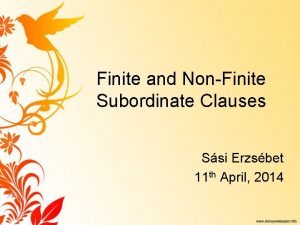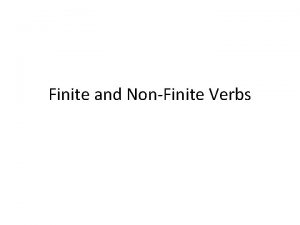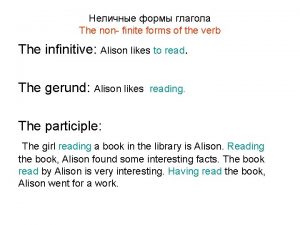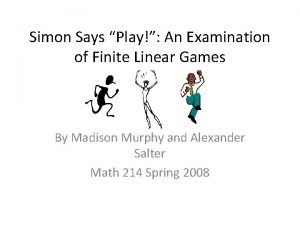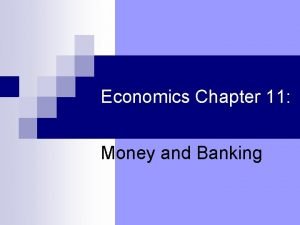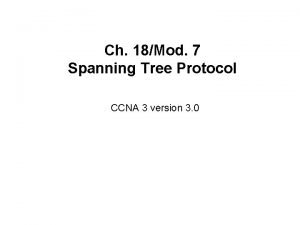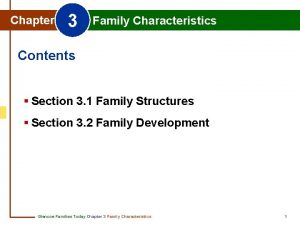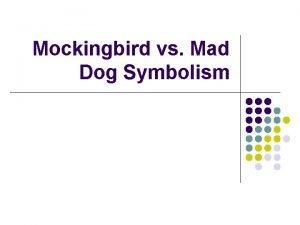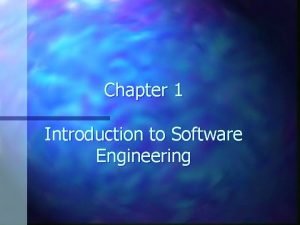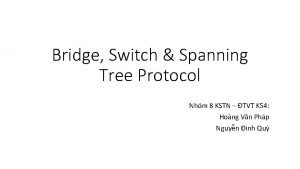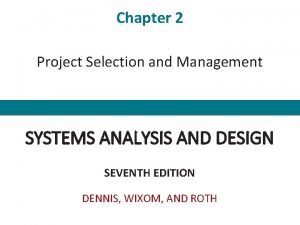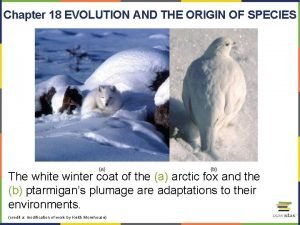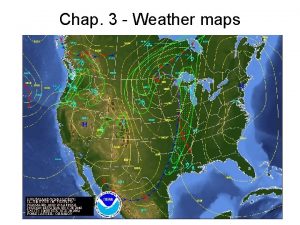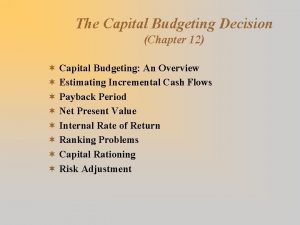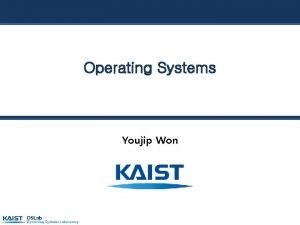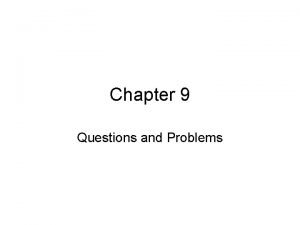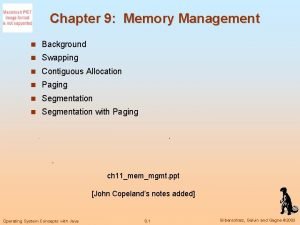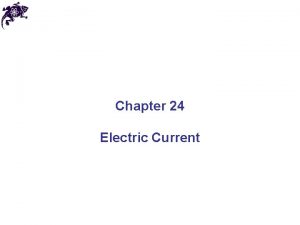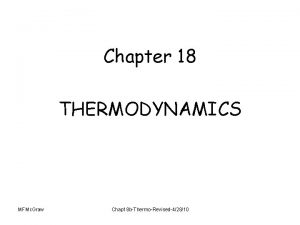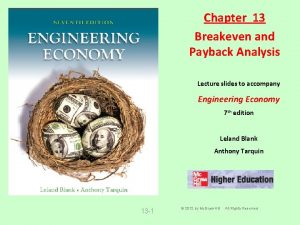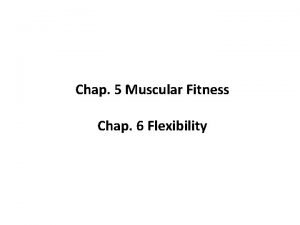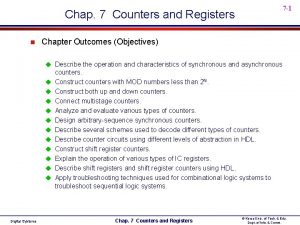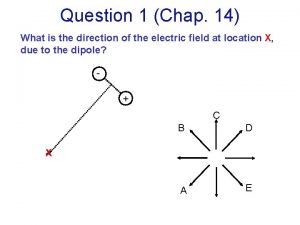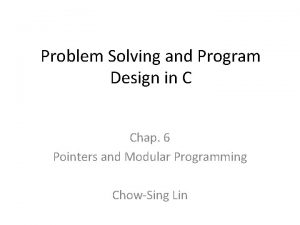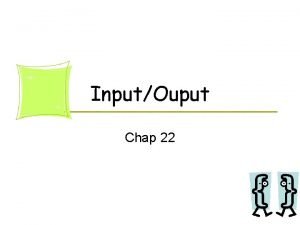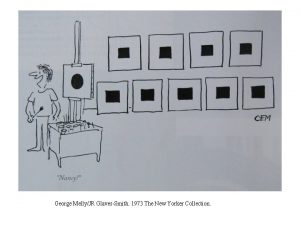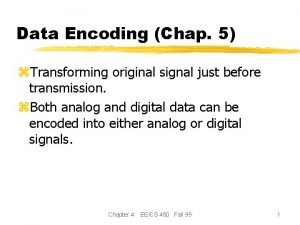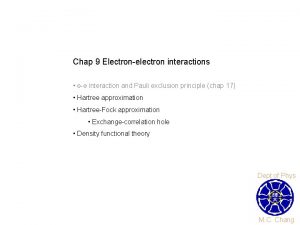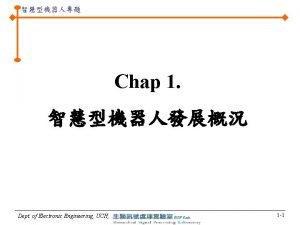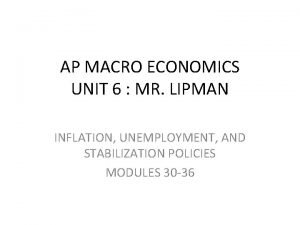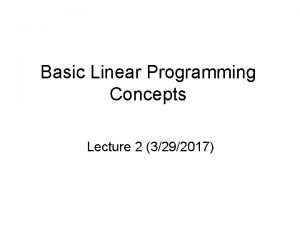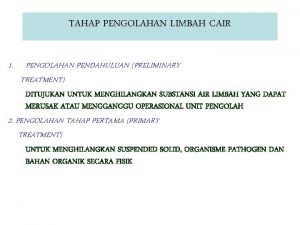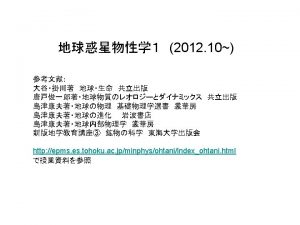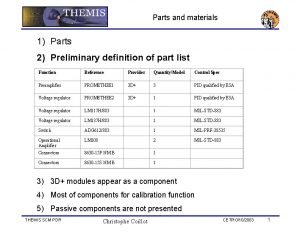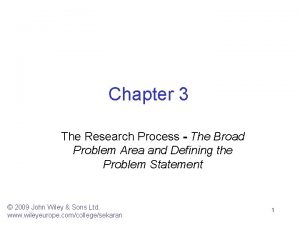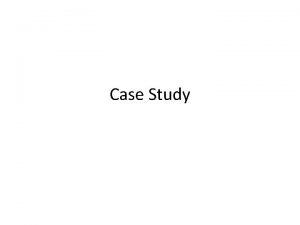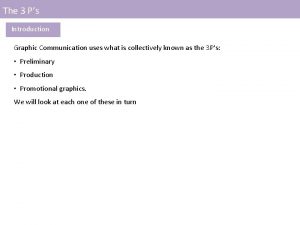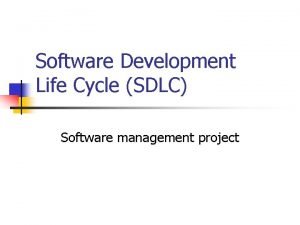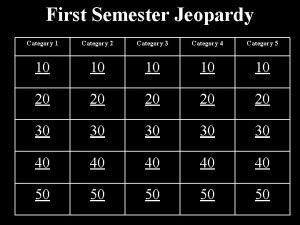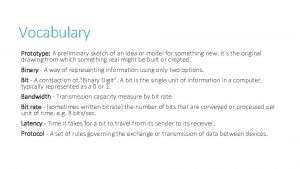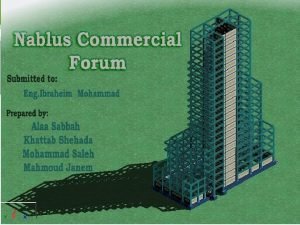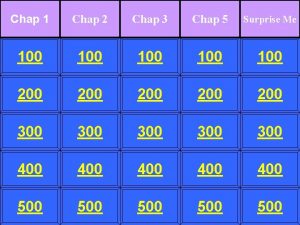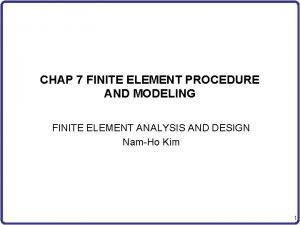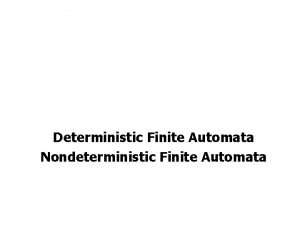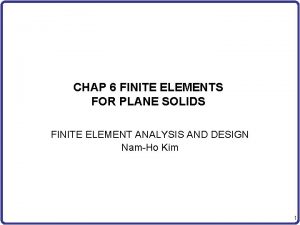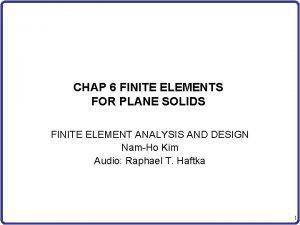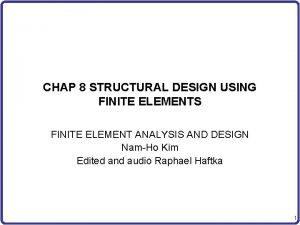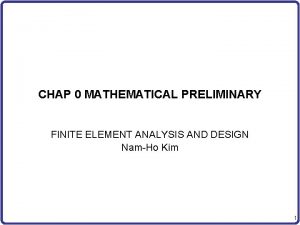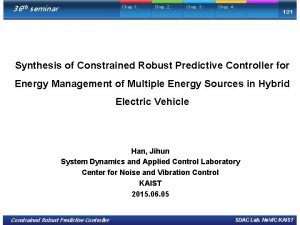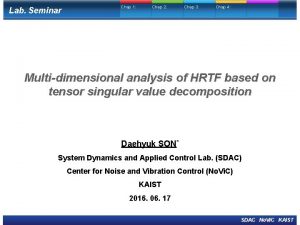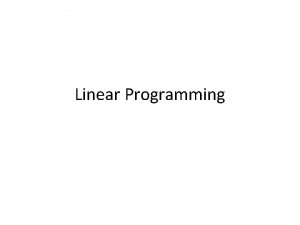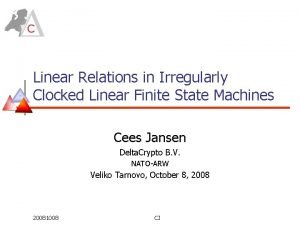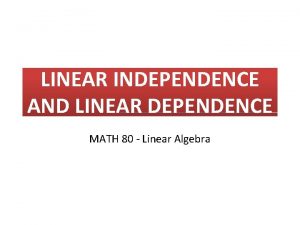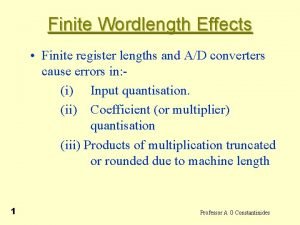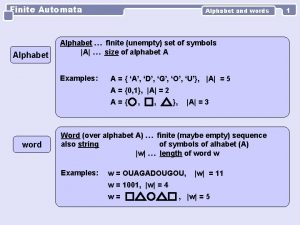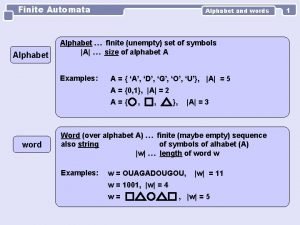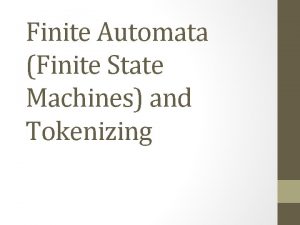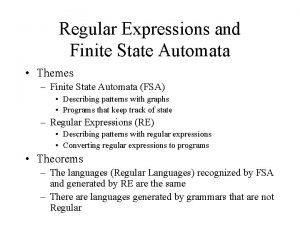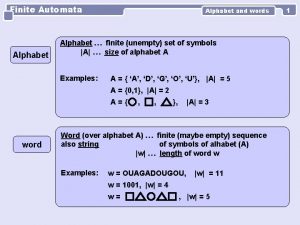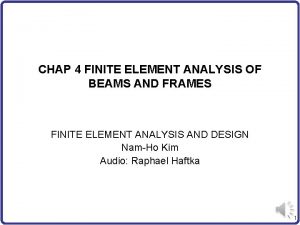1 CHAP 1 Preliminary Concepts and Linear Finite

























![Quiz • A symmetric rank four tensor is defined by where 1 = [dij] Quiz • A symmetric rank four tensor is defined by where 1 = [dij]](https://slidetodoc.com/presentation_image/3ca3e9dd02dc68ece039ab48373c444e/image-26.jpg)









































































![function [SF, GDSF, DET] = SHAPEL(XI, ELXY) %************************************* % Compute shape function, derivatives, and function [SF, GDSF, DET] = SHAPEL(XI, ELXY) %************************************* % Compute shape function, derivatives, and](https://slidetodoc.com/presentation_image/3ca3e9dd02dc68ece039ab48373c444e/image-100.jpg)


- Slides: 102

1

CHAP 1 Preliminary Concepts and Linear Finite Elements Instructor: Nam-Ho Kim (nkim@ufl. edu) Web: http: //www 2. mae. ufl. edu/nkim/INFEM/ 2

Table of Contents 1. 1. INTRODUCTION 1. 2. VECTOR AND TENSOR CALCULUS 1. 3. STRESS AND STRAIN 1. 4. MECHANICS OF CONTINUOUS BODIES 1. 5. FINITE ELEMENT METHOD 3

1. 1 INTRODUCTION 4

Background • Finite Element Method (FEM): – a powerful tool for solving partial differential equations and integro-differential equations • Linear FEM: – methods of modeling and solution procedure are well established • Nonlinear FEM: – different modeling and solution procedures based on the characteristics of the problems complicated – many textbooks in the nonlinear FEMs emphasize complicated theoretical parts or advanced topics • This book: – to simply introduce the nonlinear finite element analysis procedure and to clearly explain the solution procedure – detailed theories, solution procedures, and implementation using MATLAB for only representative problems 5

Chapter Outline 2. Vector and Tensor Calculus – Preliminary to understand mathematical derivations in other chapters 3. Stress and Strain – Review of mechanics of materials and elasticity 4. Mechanics of Continuous Bodies – Energy principles for structural equilibrium (principle of minimum potential energy) – Principle of virtual work for more general non-potential problems 5. Finite Element Method – Discretization of continuum equations and approximation of solution using piecewise polynomials – Introduction to MATLAB program ELAST 3 D 6

1. 2 VECTOR AND TENSOR CALCULUS 7

Vector and Tensor • Vector: Collection of scalars • Cartesian vector: Euclidean vector defined using Cartesian coordinates y – 2 D, 3 D Cartesian vectors u 2 e 3 z x e 1 u 3 – Using basis vectors: e 1 = {1, 0, 0}T, e 2 = {0, 1, 0}T, e 3 = {0, 0, 1}T 8

Index Notation and Summation Rule • Index notation: Any vector or matrix can be expressed in terms of its indices • Einstein summation convention Repeated indices mean summation!! – In this case, k is a dummy variable (can be j or i) – The same index cannot appear more than twice • Basis representation of a vector – Let ek be the basis of vector space V – Then, any vector in V can be represented by 9

Index Notation and Summation Rule cont. • Examples – Matrix multiplication: – Trace operator: – Dot product: – Cross product: Permutation symbol – Contraction : double dot product 10

Cartesian Vector X 3 • Cartesian Vectors v e 3 e 1 • Dot product u e 2 X 1 – Kronecker delta function – Equivalent to change index j to i, or vice versa • How to obtain Cartesian components of a vector Projection • Magnitude of a vector (norm): 11

Notation Used Here Direct tensor notation Tensor component notation Matrix notation 12

Tensor and Rank • Tensor – A tensor is an extension of scalar, vector, and matrix (multidimensional array in a given basis) – A tensor is independent of any chosen frame of reference – Tensor field: a tensor-valued function associated with each point in geometric space • Rank of Tensor – No. of indices required to write down the components of tensor – Scalar (rank 0), vector (rank 1), matrix (rank 2), etc – Every tensor can be expressed as a linear combination of rank 1 tensors – Rank 1 tensor v: vi – Rank 2 tensor A: Aij – Rank 4 tensor C: Cijkl Rank-2 stress tensor 13

Tensor Operations • Basic rules for tensors Different notations Identity tensor • Tensor (dyadic) product: increase rank • Rank-4 tensor: 14

Tensor Operations cont. • Symmetric and skew tensors – Symmetric – Skew – Every tensor can be uniquely decomposed by symmetric and skew tensors – Note: W has zero diagonal components and Wij = - Wji • Properties – Let A be a symmetric tensor 15

Example • Displacement gradient can be considered a tensor (rank 2) Strain tensor Spin tensor 16

Contraction and Trace • Contraction of rank-2 tensors – contraction operator reduces four ranks from the sum of ranks of two tensors • magnitude (or, norm) of a rank-2 tensor • Constitutive relation between stress and strain • Trace: part of contraction – In tensor notation 17

Orthogonal Tensor • In two different coord. • Direction cosines • Change basis e 3 e 1 e 3* * e 2 e 1 e 2* We can also show Orthogonal tensor Rank-2 tensor transformation 18

Permutation • The permutation symbol has three indices, but it is not a tensor • the permutation is zero when any of two indices have the same value: e 112 = e 121 = e 111 = 0 • Identity • vector product 19

Dual Vector • For any skew tensor W and a vector u – Wu and u are orthogonal • Let • Then, Dual vector of skew tensor W 20

Vector and Tensor Calculus • Gradient – Gradient is considered a vector – We will often use a simplified notation: • Laplace operator • Gradient of a scalar field f(X): vector 21

Vector and Tensor Calculus • Gradient of a Tensor Field (increase rank by 1) • Divergence (decrease rank by 2) – Ex) • Curl 22

Integral Theorems • Divergence Theorem n: unit outward normal vector • Gradient Theorem c • Stokes Theorem G r • Reynolds Transport Theorem 23

Integration-by-Parts • u(x) and v(x) are continuously differentiable functions • 1 D • 2 D, 3 D • For a vector field v(x) • Green’s identity 24

Example: Divergence Theorem • S: unit sphere (x 2 + y 2 + z 2 = 1), F = 2 xi + y 2 j + z 2 k • Integrate 25
![Quiz A symmetric rank four tensor is defined by where 1 dij Quiz • A symmetric rank four tensor is defined by where 1 = [dij]](https://slidetodoc.com/presentation_image/3ca3e9dd02dc68ece039ab48373c444e/image-26.jpg)
Quiz • A symmetric rank four tensor is defined by where 1 = [dij] is a unit tensor of rank-two and is a symmetric unit tensor of rank-four. When E is an arbitrary symmetric rank-two tensor, calculate S = D: E in terms of E. 26

1. 3 STRESS AND STRAIN 27

Surface Traction (Stress) • Surface traction (Stress) – The entire body is in equilibrium with external forces (f 1 ~ f 6) – The imaginary cut body is in equilibrium due to external forces (f 1, f 2, f 3) and internal forces – Internal force acting at a point P on a plane whose unit normal is n: – The surface traction depends on the unit normal direction n. – Surface traction will change as n changes. – unit = force per unit area (pressure) 28

Cartesian Stress Components • Surface traction changes according to the direction of the surface. • Impossible to store stress information for all directions. • Let’s store surface traction parallel to the three coordinate directions. • Surface traction in other directions can be calculated from them. • Consider the x-face of an infinitesimal cube x z Normal stress z s 13 F s 11 Shear stress x y s 12 y 29

Stress Tensor – First index is the face and the second index is its direction – When two indices are the same, normal stress, otherwise shear stress. – Continuation for other surfaces. – Total nine components – Same stress components are defined for the negative planes. • Rank-2 Stress Tensor s 33 x • Sign convention z z s 31 s 13 s 23 s 12 s 21 s 11 y x s 32 s 22 y 30

Symmetry of Stress Tensor – Stress tensor should be symmetric 9 components 6 components – Equilibrium of the angular moment – Similarly for all three directions: – Let’s use vector notation: Cartesian components of stress tensor 31

Stress in Arbitrary Plane – If Cartesian stress components are known, it is possible to determine the surface traction acting on any plane. – Consider a plane whose normal is n. y – Surface area ( ABC = A) B – The surface traction s 13 s 11 – Force balance z C s 31 s 33 n t(n) s 32 s 12 P s 21 s 23 A x s 22 32

Cauchy’s Lemma • All three-directions • Tensor notation – stress tensor; completely characterize the state of stress at a point • Cauchy’s Lemma – the surface tractions acting on opposite sides of the same surface are equal in magnitude and opposite in direction 33

Projected Stresses • Normal stress • Shear stress • Principal stresses • Mean stress (hydrostatic pressure) • Stress deviator Rank-4 identity tensor Rank-4 deviatoric identity tensor 34

Principal Stresses • Normal & shear stress change as n changes – Is there a plane on which the normal (or shear)stress becomes the maximum? • There at least three mutually perpendicular planes on which the normal stress attains an extremum – Shear stresses are zero on these planes Principal directions – Traction t(n) is parallel to surface normal n • Eigenvalue problem Principal stress Principal direction 35

Eigenvalue Problem for Principal Stresses • The eigenvalue problem has non-trivial solution if and only if the determinant is zero: • The above equation becomes a cubic equation: • Three roots are principal stresses 36

Principal Directions • Stress Invariants: I 1, I 2, I 3 – independent of the coordinate system • Principal directions – Substitute each principal stress to the eigenvalue problem to get n – Since the determinant is zero, an infinite number of solutions exist – Among them, choose the one with a unit magnitude • Principal directions are mutually perpendicular 37

Principal Directions • There are three cases for principal directions: 1. σ1, σ2, and σ3 are distinct principal directions are three unique mutually orthogonal unit vectors. 2. σ1 = σ2 and σ3 are distinct n 3 is a unique principal direction, and any two orthogonal directions on the plane that is perpendicular to n 3 are principal directions. 3. σ1 = σ2 = σ3 any three orthogonal directions are principal directions. This state of stress corresponds to a hydrostatic pressure. n 3 38

Strains (Simple Version) – Strain is defined as the elongation per unit length u 2 x 2 P x 1 u 1 P – Tensile (normal) strains in x 1 - and x 2 -directions Textbook has different, but more rigorous derivations – Strain is a dimensionless quantity. Positive for elongation and negative for compression 39

Shear Strain – Shear strain is the tangent of the change in angle between two originally perpendicular axes u 1 q 2 x 2 – Shear strain (change of angle) P p/2 – g 12 q 1 u 2 x 1 – Positive when the angle between two positive (or two negative) faces is reduced and negative when the angle is increased. – Valid for small deformation 40

Strains (Rigorous Version) • Strain: a measure of deformation – Normal strain: change in length of a line segment – Shear strain: change in angle between two perpendicular line segments • Displacement of P = (u 1, u 2, u 3) • Displacement of Q & R R' Q' R P'(x 1+u 1, x 2+u 2, x 3+u 3) x 2 x 1 P(x 1, x 2, x 3) Q x 2 x 1 x 3 41

Displacement Field • Coordinates of P, Q, and R before and after deformation • Length of the line segment P'Q' 42

Deformation Field • Length of the line segment P'Q' Linear Nonlinear Ignore H. O. T. when displacement gradients are small • Linear normal strain 43

Deformation Field • Shear strain gxy – change in angle between two lines originally parallel to x– and y– axes Engineering shear strain Different notations 44

Strain Tensor • Strain Tensor • Cartesian Components • Vector notation 45

Volumetric and Deviatoric Strain • Volumetric strain (from small strain assumption) • Deviatoric strain x 3 e 33 e 22 1 x 2 1 1 e 11 x 1 Exercise: Write Idev in matrix-vector notation 46

Stress-Strain Relationship • Applied Load shape change (strain) stress • There must be a relation between stress and strain • Linear Elasticity: Simplest and most commonly used s Ultimate stress Fracture Yield stress Proportional limit Young’s modulus Strain Necking hardening e 47

Generalized Hooke’s Law • Linear elastic material – In general, Dijkl has 81 components – Due to symmetry in sij, Dijkl = Djikl – Due to symmetry in ekl, Dijkl = Dijlk 21 independent coeff – from definition of strain energy, Dijkl = Dklij • Isotropic material (no directional dependence) – Most general 4 -th order isotropic tensor – Have only two independent coefficients (Lame’s constants: l and m) 48

Generalized Hooke’s Law cont. • Stress-strain relation – Volumetric strain: – Off-diagonal part: m is the shear modulus – Bulk modulus K: relation b/w volumetric stress & strain – Substitute Bulk modulus so that we can separate volumetric part • Total deform. = volumetric + deviatoric deform. 49

Generalized Hooke’s Law cont. • Stress-strain relation cont. Deviatoric part Volumetric part Deviatoric strain Deviatoric stress Important for plasticity; plastic deformation only occurs in deviatoric part volumetric part is always elastic 50

Generalized Hooke’s Law cont. • Vector notation – The tensor notation is not convenient for computer implementation nd – Thus, we use Voigt notation 2 -order tensor vector 4 th-order tensor matrix – Strain (6× 1 vector), Stress (6× 1 vector), and C (6× 6 matrix) e 12 + e 21 = 2 e 12 You don’t need 2 here 51

3 D Solid Element cont. • Elasticity matrix • Relation b/w Lame’s constants and Young’s modulus and Poisson’s ratio Textbook has a definition of D in terms of E and n 52

Plane Stress • Thin plate–like components parallel to the xy–plane • The plate is subjected to forces in its in-plane only • s 13 = s 23 = s 33 = 0 • • e 13 = e 23 = 0, but e 33 ≠ 0 e 33 can be calculated from the condition of s 33 = 0: 53

Plane Strain • Strains with a z subscript are all zero: e 13 = e 23 = e 33 = 0 • Deformation in the z–direction is constrained, (i. e. , u 3 = 0) • can be used if the structure is infinitely long in the z– direction • • s 13 = s 23 = 0, but s 33 ≠ 0 s 33 can be calculated from the condition of e 33 = 0: 54

1. 4 MECHANICS OF CONTINUOUS BODIES 55

Governing Equations for Equilibrium • Governing differential equations for structural equilibrium – Three laws of mechanics: conservation of mass, conservation of linear momentum and conservation of angular momentum • Boundary-valued problem: satisfied at every point in W – Governing D. E. + Boundary conditions – Solutions: C 2–continuous for truss & solid, C 4–continuous for beam – Unnecessarily requirements for higher-order continuity • Energy-based method – For conservative system, structural equilibrium when the potential energy has its minimum: Principle of minimum potential energy – If the solution of BVP exists, then that solution is the minimizing solution of the potential energy – When no solution exists in BVP, PMPE may have a natural solution • Principle of virtual work – Equilibrium of the work done by both internal and external forces with small arbitrary virtual displacements 56

Balance of Linear Momentum • Balance of linear momentum fb: body force tn: surface traction • Stress tensor (rank 2): 0 for static problem G • Surface traction X • Cauchy’s Lemma e 1 X 1 e 3 W X 3 e 2 n X 2 tn 57

Balance of Linear Momentum cont • Balance of linear momentum Divergence Theorem – For a static problem • Balance of angular momentum 58

Boundary-Valued Problem • We want to determine the state of a body in equilibrium • The equilibrium state (solution) of the body must satisfy – local momentum balance equation – boundary conditions G • Strong form of BVP X – Given body force fb, and traction the boundary, find u such that and e 1 (2) (3) fb X 3 (1) X 1 W e 3 e 2 n X 2 t • Solution space 59

Boundary-Valued Problem cont. • How to solve BVP – To solve the strong form, we want to construct trial solutions that automatically satisfy a part of BVP and find the solution that satisfy remaining conditions. – Statically admissible stress field: satisfy (1) and (3) – Kinematically admissible displacement field : satisfy (2) and have piecewise continuous first partial derivative – Admissible stress field is difficult to construct. Thus, admissible displacement field is used often 60

Principle of Minimum Potential Energy (PMPE) • Deformable bodies generate internal forces by deformation against externally applied forces • Equilibrium: balance between internal and external forces • For elastic materials, the concept of force equilibrium can be extended to energy balance • Strain energy: stored energy due to deformation (corresponding to internal force) Linear elastic material • For elastic material, U(u) is only a function of total displacement u (independent of path) 61

PMPE cont. • Work done by applied loads (conservative loads) • U(u) is a quadratic function of u, while W(u) is a linear function of u. Gg fb x 3 u 2 u 1 W Gh fs • Potential energy x 2 x 1 62

PMPE cont. • PMPE: for all displacements that satisfy the boundary conditions, known as kinematically admissible displacements, those which satisfy the boundary-valued problem make the total potential energy stationary on DA • But, the potential energy is well defined in the space of kinematically admissible displacements H 1: first-order derivatives are integrable • No need to satisfy traction BC (it is a part of potential) • Less requirement on continuity • The solution is called a generalized (natural) solution 63

Example – Uniaxial Bar • Strong form x F L • Integrate twice: • Apply two BCs: Solution of BVP • PMPE with assumed solution u(x) = c 1 x + c 2 • To satisfy KAD space, u(0) = 0, u(x) = c 1 x • Potential energy: 64

Virtual Displacement • Virtual displacement is not experienced but only assumed to exist so that various possible equilibrium positions may be compared to determine the correct one • Let mass m and springs are in equilibrium at the current position • Then, a small arbitrary perturbation, dr, can be assumed – Since dr is so small, the member forces are assumed unchanged • The work done by virtual displacement is • If the current position is in force equilibrium, d. W = 0 F 2 F 3 dr F 1 F 4 65

Virtual Displacement Field • Virtual displacement (Space ) – Small arbitrary perturbation (variation) of real displacement – Let ū be the virtual displacement, then u + ū must be kinematically admissible, too – Then, ū must satisfy homogeneous displacement BC ū u – Space only includes homogeneous essential BCs In the literature, du is often used instead of ū • Property of variation 66

PMPE As a Variation • Necessary condition for minimum PE – Stationary condition <--> first variation = 0 • Variation of strain energy Energy bilinear form 67

PMPE As a Variation cont. • Variation of work done by applied loads Load linear form • Thus, PMPE becomes – Load form is linear with respect to ū – Energy form a(u, ū) is symmetric, bilinear w. r. t. u and ū – Different problems have different a(u, ū) and the same property , but they share • How can we satisfy “for allū ” requirement? Can we test an infinite number of ū? 68

Example – Uniaxial Bar • Assumed displacement u(x) = cx – virtual displacement is in the same space with u(x): • Variation of strain energy • Variation of applied load • PMPE Arbitrary arbitrary coefficient of must be zero 69

Principle of Virtual Work • Instead of solving the strong form directly, we want to solve the equation with relaxed requirement (weak form) • Virtual work – Work resulting from real forces acting through a virtual displacement • Principle of virtual work – when a system is in equilibrium, the forces applied to the system will not produce any virtual work for arbitrary virtual displacements – Balance of linear momentum is force equilibrium – Thus, the virtual work can be obtained by multiplying the force equilibrium equation with a virtual displacement – If the above virtual work becomes zero for arbitrary ū, then it satisfies the original equilibrium equation in a weak sense 70

Principle of Virtual Work cont • PVW – Integration-by-parts – Divergence Thm – The boundary is decomposed by 71

Principle of Virtual Work cont • Since sij is symmetric • Weak Form of BVP Internal virtual work = external virtual work Starting point of FEM • Symbolic expression FE equation – Energy form: – Load form: 72

Example – Heat Transfer Problem • Steady-State Differential Equation T = T 0 domain A • Boundary conditions qn Sq ST Q n = {nx, ny}T • Space of kinematically admissible temperature • Multiply by virtual temperature, integrate by part, and apply boundary conditions 73

Example – Beam Problem • Governing DE f(x) x L • Boundary conditions for cantilevered beam • Space of kinematically admissible displacement • Integrate-by-part twice, and apply BCs 74

Difference b/w Strong and Weak Solutions • The solution of the strong form needs to be twice differentiable • The solution of the weak form requires the first-order derivatives are integrable bigger solution space than that of the strong form • If the strong form has a solution, it is the solution of the weak form • If the strong form does not have a solution, the weak form may have a natural solution F 75

1. 5 FINITE ELEMENT METHOD 76

Finite Element Approximation • Difficult to solve a variational equation analytically • Approximate solution – Linear combination of trial functions – Smoothness & accuracy depend on the choice of trial functions – If the approximate solution is expressed in the entire domain, it is difficult to satisfy kinematically admissible conditions • Finite element approximation – Approximate solution in simple sub-domains (elements) – Simple trial functions (low-order polynomials) within an element – Kinematically admissible conditions only for elements on the boundary u(x) Nodes Piecewiselinear approximation Approximate solution x Finite elements Exact solution 77

Finite Elements • Types of finite elements 1 D 2 D 3 D Linear Quadratic • Variational equation is imposed on each element. One element 78

Trial Solution – Solution within an element is approximated using simple polynomials. – i-th element is composed of two nodes: xi and xi+1. Since two unknowns are involved, linear polynomial can be used: – The unknown coefficients, a 0 and a 1, will be expressed in terms of nodal solutions u(xi) and u(xi+1). 79

Trial Solution cont. – Substitute two nodal values – Express a 0 and a 1 in terms of ui and ui+1. Then, the solution is approximated by – Solution for Element e: – N 1(x) and N 2(x): Shape Function or Interpolation Function 80

Trial Solution cont. • Observations – Solution u(x) is interpolated using its nodal values ui and ui+1. – N 1(x) = 1 at node xi, and =0 at node xi+1. N 1(x) xi N 2(x) xi+1 – The solution is approximated by piecewise linear polynomial and its gradient is constant within an element. – Stress and strain (derivative) are often averaged at the node. 81

1 D Finite Elements • 1 D BVP Space of kinematically admissible displacements • Use PVW • Integration-by-parts – This variational equation also satisfies at individual element level (1) 82

1 D Interpolation Functions • Finite element approximation for one element (e) at a time • Satisfies interpolation condition • Interpolation of displacement variation (same with u) • Derivative of u(x): differentiating interpolation functions 83

Element-Level Variational Equation • Approximate variational equation (1) for element (e) – Must satisfied for all – If element (e) is not on the boundary, can be arbitrary • Element-level variational equation 2 x 2 matrix 2 x 1 vector 84

Assembly • Need to derive the element-level equation for all elements • Consider Elements 1 and 2 (connected at Node 2) • Assembly Vanished unknown term 85

Assembly cont. • Assembly of NE elements (ND = NE + 1) • Coefficient matrix [K] is singular; it will become nonsingular after applying boundary conditions 86

Example • Use three equal-length elements • All elements have the same coefficient matrix • RHS (p(x) = x) 87

Example cont. • RHS cont. • Assembly Element 1 Element 2 Element 3 • Apply boundary conditions – Deleting 1 st and 4 th rows and columns 88

EXAMPLE cont. • Approximate solution • Exact solution – Three element solutions are poor – Need more elements 89

3 D Solid Element • Isoparametric mapping – Build interpolation functions on the reference element – Jacobian: mapping relation between physical and reference elem. • Interpolation and mapping Same for mapping and interpolation x 8 x 7 (– 1, 1) (1, – 1, 1) x 5 x 6 x 3 x 1 z (– 1, 1, 1) (1, 1, 1) h x 4 x 3 x 2 (a) Finite Element (1, – 1) x (– 1, 1, – 1) (b) Reference Element 90

3 D Solid Element cont. • Jacobian matrix : Jacobian • Derivatives of shape functions – Jacobian should not be zero anywhere in the element – Zero or negative Jacobian: mapping is invalid (bad element shape) 91

3 D Solid Element cont. • Displacement-strain relation 92

3 D Solid Element cont. • Transformation of integration domain • Energy form • Load form • Discrete variational equation 93

Numerical Integration • For bar and beam, analytical integration is possible • For plate and solid, analytical integration is difficult, if not impossible • Gauss quadrature is most popular in FEM due to simplicity and accuracy • 1 D Gauss quadrature – NG: No. of integ. points; xi: integ. point; wi: integ. weight – xi and wi are chosen so that the integration is exact for (2*NG – 1)-order polynomial – Works well for smooth function – Integration domain is [-1, 1] 94

Numerical Integration cont. • Multi-dimensions NG 1 2 3 4 5 Integration Points (xi) 0. 0 . 5773502692 . 7745966692 0. 0 . 8611363116 . 3399810436 . 9061798459 . 5384693101 0. 0 h Weights (wi) 2. 0 1. 0. 555556. 888889. 3478546451. 6521451549. 2369268851. 4786286705. 5688888889 x h (a) 1 1 h x (b) 2 2 x (c) 3 3 95

ELAST 3 D. m • A module to solve linear elastic problem using NLFEA. m • Input variables for ELAST 3 D. m Variable Array size Meaning ETAN (6, 6) Elastic stiffness matrix Eq. (1. 81) UPDATE Logical variable If true, save stress values LTAN Logical variable If true, calculate the global stiffness matrix NE Integer Total number of elements NDOF Integer Dimension of problem (3) XYZ (3, NNODE) Coordinates of all nodes LE (8, NE) Element connectivity 96

How to Solve Linear Problem in Nonlinear Code • Linear matrix solver {fint} = {fext} {f} = {fext} − {fint} = {0} – Construct stiffness matrix and force vector – Use LU decomposition to solve for unknown displacement {d} • Nonlinear solver (iterative solver) – Assume the solution at iteration n is known, and n+1 is unknown For linear problem, {dn} = {0} Only one iteration!! 97

function ELAST 3 D(ETAN, UPDATE, LTAN, NE, NDOF, XYZ, LE) %************************************ % MAIN PROGRAM COMPUTING GLOBAL STIFFNESS MATRIX AND RESIDUAL FORCE FOR % ELASTIC MATERIAL MODELS %************************************ %% global DISPTD FORCE GKF SIGMA % % Integration points and weights (2 -point integration) XG=[-0. 57735026918963 D 0, 0. 57735026918963 D 0]; WGT=[1. 0000000 D 0, 1. 0000000 D 0]; % % Index for history variables (each integration pt) INTN=0; % %LOOP OVER ELEMENTS, THIS IS MAIN LOOP TO COMPUTE K AND F for IE=1: NE % Nodal coordinates and incremental displacements ELXY=XYZ(LE(IE, : ); % Local to global mapping IDOF=zeros(1, 24); for I=1: 8 II=(I-1)*NDOF+1; IDOF(II: II+2)=(LE(IE, I)-1)*NDOF+1: (LE(IE, I)-1)*NDOF+3; end DSP=DISPTD(IDOF); DSP=reshape(DSP, NDOF, 8); % %LOOP OVER INTEGRATION POINTS for LX=1: 2, for LY=1: 2, for LZ=1: 2 E 1=XG(LX); E 2=XG(LY); E 3=XG(LZ); INTN = INTN + 1; % % Determinant and shape function derivatives [~, SHPD, DET] = SHAPEL([E 1 E 2 E 3], ELXY); FAC=WGT(LX)*WGT(LY)*WGT(LZ)*DET ; 98

% Strain DEPS=DSP*SHPD'; DDEPS=[DEPS(1, 1) DEPS(2, 2) DEPS(3, 3). . . DEPS(1, 2)+DEPS(2, 1) DEPS(2, 3)+DEPS(3, 2) DEPS(1, 3)+DEPS(3, 1)]'; % % Stress STRESS = ETAN*DDEPS; % % Update stress if UPDATE SIGMA(: , INTN)=STRESS; continue; end % % Add residual force and stiffness matrix BM=zeros(6, 24); for I=1: 8 COL=(I-1)*3+1: (I-1)*3+3; BM(: , COL)=[SHPD(1, I) 0 0; 0 SHPD(2, I) 0; 0 0 SHPD(3, I); SHPD(2, I) SHPD(1, I) 0; 0 SHPD(3, I) SHPD(2, I); SHPD(3, I) 0 SHPD(1, I)]; end % % Residual forces FORCE(IDOF) = FORCE(IDOF) - FAC*BM'*STRESS; % % Tangent stiffness if LTAN EKF = BM'*ETAN*BM; GKF(IDOF, IDOF)=GKF(IDOF, IDOF)+FAC*EKF; end, end 99
![function SF GDSF DET SHAPELXI ELXY Compute shape function derivatives and function [SF, GDSF, DET] = SHAPEL(XI, ELXY) %************************************* % Compute shape function, derivatives, and](https://slidetodoc.com/presentation_image/3ca3e9dd02dc68ece039ab48373c444e/image-100.jpg)
function [SF, GDSF, DET] = SHAPEL(XI, ELXY) %************************************* % Compute shape function, derivatives, and determinant of hexahedral element %************************************* %% XNODE=[-1 1 1 -1; -1 -1 1 1; -1 -1 1 1]; SF(8 1): shape functions, QUAR = 0. 125; SF=zeros(8, 1); DSF=zeros(3, 8); GDSF (3 8): shape functions derivatives for I=1: 8 XP = XNODE(1, I); YP = XNODE(2, I); DET: Jacobian of the mapping ZP = XNODE(3, I); % XI 0 = [1+XI(1)*XP 1+XI(2)*YP 1+XI(3)*ZP]; % SF(I) = QUAR*XI 0(1)*XI 0(2)*XI 0(3); DSF(1, I) = QUAR*XP*XI 0(2)*XI 0(3); DSF(2, I) = QUAR*YP*XI 0(1)*XI 0(3); DSF(3, I) = QUAR*ZP*XI 0(1)*XI 0(2); end GJ = DSF*ELXY; DET = det(GJ); GJINV=inv(GJ); GDSF=GJINV*DSF; end 100

One Element Tension Example x 3 % 10 k. N % One element example % 5 10 k. N % Nodal coordinates 10 k. N 8 XYZ=[0 0 0; 1 1 0; 0 0 1; 1 1 1; 0 1 1]; % % Element connectivity 6 LE=[1 2 3 4 5 6 7 8]; 7 % % External forces [Node, DOF, Value] EXTFORCE=[5 3 10. 0 E 3; 6 3 10. 0 E 3; 7 3 10. 0 E 3; 8 3 10. 0 E 3]; 4 % 1 % Prescribed displacements [Node, DOF, Value] SDISPT=[1 1 0; 1 2 0; 1 3 0; 2 2 0; 2 3 0; 3 3 0; 4 1 0; 4 3 0]; % 2 % Material properties x 1 3 % MID: 0(Linear elastic) PROP=[LAMBDA NU] MID=0; PROP=[110. 747 E 3 80. 1938 E 3]; % % Load increments [Start End Increment Initial. Factor Final. Factor] TIMS=[0. 0 1. 0]'; % % Set program parameters ITRA=30; ATOL=1. 0 E 5; NTOL=6; TOL=1 E-6; % % Calling main function NOUT = fopen('output. txt', 'w'); NLFEA(ITRA, TOL, ATOL, NTOL, TIMS, NOUT, MID, PROP, EXTFORCE, SDISPT, XYZ, LE); fclose(NOUT); x 2 101

One Element Output Command line output Time step Iter Residual 1. 00000 1. 000 e+00 2 5. 45697 e-12 Contents in output. txt TIME = 1. 000 e+00 Nodal Displacements Node U 1 U 2 U 3 1 0. 000 e+00 2 -5. 607 e-08 0. 000 e+00 3 -5. 607 e-08 0. 000 e+00 4 0. 000 e+00 -5. 607 e-08 0. 000 e+00 5 -5. 494 e-23 1. 830 e-23 1. 933 e-07 6 -5. 607 e-08 4. 061 e-23 1. 933 e-07 7 -5. 607 e-08 1. 933 e-07 8 -8. 032 e-23 -5. 607 e-08 1. 933 e-07 Element Stress S 11 S 22 S 33 S 12 S 23 S 13 Element 1 0. 000 e+00 1. 091 e-11 4. 000 e+04 -2. 322 e-13 6. 633 e-13 -3. 317 e-12 0. 000 e+00 4. 000 e+04 -3. 980 e-13 1. 327 e-13 -9. 287 e-13 -3. 638 e-12 7. 276 e-12 4. 000 e+04 -1. 592 e-12 -2. 123 e-12 -3. 317 e-12 0. 000 e+00 4. 000 e+04 2. 653 e-13 -2. 123 e-12 5. 307 e-13 0. 000 e+00 4. 000 e+04 5. 638 e-13 3. 449 e-12 -1. 327 e-12 0. 000 e+00 4. 000 e+04 -1. 194 e-12 4. 776 e-12 1. 061 e-12 0. 000 e+00 4. 000 e+04 -7. 960 e-13 2. 919 e-12 -3. 449 e-12 3. 638 e-12 4. 000 e+04 -5. 307 e-13 3. 715 e-12 1. 061 e-12 *** Successful end of program *** 102
 Chap chap slide
Chap chap slide Finite and non finite subordinate clauses
Finite and non finite subordinate clauses Finite verb
Finite verb Learning objectives for finite and non finite verbs
Learning objectives for finite and non finite verbs Finite and nonfinite verbs examples
Finite and nonfinite verbs examples Finite and non finite
Finite and non finite Finite linear game
Finite linear game Riddle on spices
Riddle on spices Waterfall market entry strategy
Waterfall market entry strategy Preliminary cooking and flavoring
Preliminary cooking and flavoring Windbreaker chapter 1
Windbreaker chapter 1 Passion chap 6
Passion chap 6 Bank run chap 11
Bank run chap 11 Autocorrelation ppt gujarati
Autocorrelation ppt gujarati Kstn chap 18
Kstn chap 18 Close family chap 3
Close family chap 3 The origin of species cap 24
The origin of species cap 24 Satisfying needs #1
Satisfying needs #1 The origin of species chapter 22 manhwa
The origin of species chapter 22 manhwa Mad dog ch25
Mad dog ch25 Mathew 5
Mathew 5 Child development chapter 1
Child development chapter 1 Drivers of competitive behavior
Drivers of competitive behavior System engineer chap 1
System engineer chap 1 Chap tree
Chap tree Kstn chap 7
Kstn chap 7 I was in that state when a chap easily turns nasty analysis
I was in that state when a chap easily turns nasty analysis Gradualism vs punctuated equilibrium
Gradualism vs punctuated equilibrium Passion chap 9
Passion chap 9 Bài tập về nhà
Bài tập về nhà In the summer chap 22
In the summer chap 22 Selection project 2
Selection project 2 The origin of species manhwa chapter 18
The origin of species manhwa chapter 18 Friendly relationship chapter 12
Friendly relationship chapter 12 Fitness - chapter 1
Fitness - chapter 1 Chap tree
Chap tree Surface station model
Surface station model Chap 23
Chap 23 Payback ch 12
Payback ch 12 Chapter 1 why personal fitness
Chapter 1 why personal fitness Youjip
Youjip Chapter 10 in the time of the butterflies
Chapter 10 in the time of the butterflies Pyramid of relationships in crm
Pyramid of relationships in crm Need for speed payback chapter 9
Need for speed payback chapter 9 Swapping ch 9
Swapping ch 9 Intimate family chapter 7
Intimate family chapter 7 Breathe the same air ch 1
Breathe the same air ch 1 Business performance chapter 4
Business performance chapter 4 Chapter 24
Chapter 24 Into the light chapter 22
Into the light chapter 22 To not die chap 18
To not die chap 18 Payback vs breakeven
Payback vs breakeven Payback criterion formula
Payback criterion formula Define the relationship chapter 11
Define the relationship chapter 11 Fitness chap 1
Fitness chap 1 Pleasure principle chap 1
Pleasure principle chap 1 A thousand splendid suns chapters
A thousand splendid suns chapters Chap counter
Chap counter English patient setting
English patient setting Chap de direction
Chap de direction C chap
C chap Chap 22
Chap 22 Rottgen pieta
Rottgen pieta Chap a to z
Chap a to z Fitness chapter 1
Fitness chapter 1 Khan academy galvanic cells
Khan academy galvanic cells Cell chap 14
Cell chap 14 Hf chap
Hf chap What does chap look like
What does chap look like Deng chap
Deng chap Chap tools
Chap tools Electronic engineering
Electronic engineering Chap lipman
Chap lipman Which do you prefer ch 4
Which do you prefer ch 4 Linear programming definition
Linear programming definition Preliminary budget
Preliminary budget Preliminary treatment adalah
Preliminary treatment adalah Preliminary survey audit
Preliminary survey audit Preliminary reference earth model
Preliminary reference earth model Preliminary design review example
Preliminary design review example Preliminary materials
Preliminary materials Mla format thesis
Mla format thesis Preliminary interview
Preliminary interview Broad problem area in research
Broad problem area in research Hopi corporation expects the following
Hopi corporation expects the following Ang pinakaunang pahina ng pamanahong papel
Ang pinakaunang pahina ng pamanahong papel 3 p's graphic communication
3 p's graphic communication Sdlc
Sdlc Preliminary thesis example
Preliminary thesis example Preliminary rifle instruction
Preliminary rifle instruction Arrt preliminary score
Arrt preliminary score Image of development
Image of development Gauge refers to what quality of the film strip
Gauge refers to what quality of the film strip Determine junktrader’s preliminary net income.
Determine junktrader’s preliminary net income. What information do you obtain from preliminary test curls
What information do you obtain from preliminary test curls Preliminary business plan
Preliminary business plan Preliminary prototype
Preliminary prototype Preliminary audit strategy
Preliminary audit strategy Preliminary outline
Preliminary outline Pre softening milady
Pre softening milady Practical assistance for expatriates
Practical assistance for expatriates Preliminary objectives
Preliminary objectives Process of advertising research
Process of advertising research

